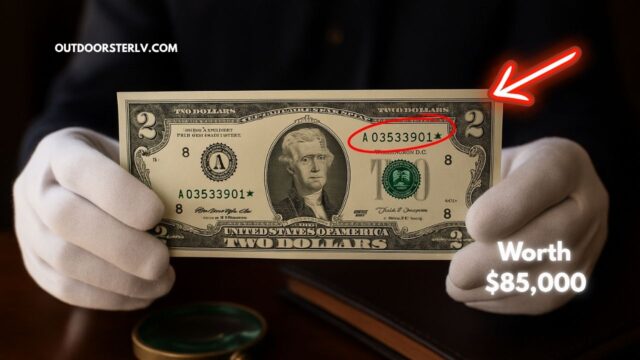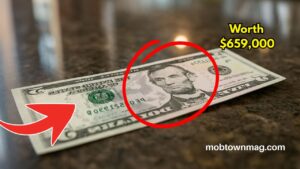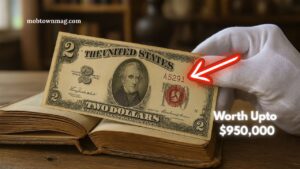A wave of headlines claims a 2017A $2 bill with a unique serial number could be worth $85,000. It’s a gripping story—but what’s real, what’s hype, and how do you know if your note is valuable?
This guide breaks down the facts using the latest market info: how fancy serial numbers work, which errors and print runs actually command premiums, how much certified (graded) examples sell for, and what you can realistically expect.
Why Some 2017A $2 Bills Are Valuable
Most modern $2 bills are common and worth face value. Premiums arise from three things:
- Fancy serial numbers (e.g., ladders, solids, repeaters, radars, low serials like 00000001)
- Printing errors (misaligned serials, over-inking, shifts, mismatched numbers)
- Scarce star notes / small print runs (especially when combined with great condition)
Key point: The rumored $85,000 value is an outlier claim tied to an extremely rare serial or error scenario (and typically top-tier uncirculated, graded condition). Everyday 2017A notes—even crisp ones—don’t approach that figure.
Understanding Fancy Serial Numbers (and What’s “Unique”)
A “unique” or “fancy” serial number follows a special pattern that collectors chase:
- Ladder: 01234567 or 76543210
- Solid: 11111111, 22222222, etc.
- Radar: 12344321 (reads the same forward/back)
- Repeater: 12341234
- Binary: only two digits (e.g., 10101010)
- Low serials: 00000001–00000100 often carry strong premiums
- Star notes (*) replace a defective note in a print run and can be scarcer
What Recent Market Activity Suggests
- Fancy serials bring the biggest wins when they are undeniably elite (e.g., solid 8s, perfect ladders), and graded uncirculated by PMG or PCGS.
- Error notes (over-inked, misaligned/shift errors, crooked serials) can range from modest premiums to hundreds or a few thousand dollars, depending on severity and grade.
- Star notes from smaller print runs can sell for hundreds; combining a scarce star note with a fancy pattern increases value.
2017A $2 Bill Value Snapshot (Collector-Oriented)
Note: Actual prices vary by condition, certification, district, and demand.
| Feature / Pattern (2017A $2) | Typical Real-World Range* | What Moves It Higher |
|---|---|---|
| Regular note, circulated | $2–$5 | Crispness, eye appeal |
| Regular note, uncirculated sheet-cut | $5–$20 | Consecutive runs, original packaging |
| Star note (common run) | $50–$250 | Higher grade (Gem/PPQ/EPQ), scarcer run |
| Small-run Star note | $150–$500+ | Sheet star, provenance, grading 66–68 |
| Error note (light/shift/over-inked) | $150–$800+ | Dramatic, obvious errors; top-tier grading |
| Fancy serial (radar/repeater/binary) | $150–$1,500+ | Cleaner, crisper, higher grade, perfect pattern |
| Elite fancy (solid, perfect ladder, 00000001) | $3,000–$10,000+ | Rarity + highest grading + demand |
| Hyped “$85,000” case | Extraordinary/uncorroborated | Would require extreme rarity + headline-grade demand |
*Ranges are indicative of recent market behavior; single sales can land above/below.
How to Check If Yours Is Special
- Read the serial: Look for solid, ladder, repeater, radar, or very low numbers. A star (* after the serial) can be a plus.
- Scan for errors: Are serials crooked or misaligned? Do numbers mismatch? Any heavy over-inking or printing shifts?
- Confirm the district & run: Certain star-note print runs are smaller. Scarcer runs can mean higher value.
- Assess condition: Uncirculated (UNC), Gem, and notes graded 66–68 bring the best prices. Folded, worn, or stained bills lose value fast.
- Get it graded: If you suspect a jackpot serial or dramatic error, professional grading (PMG/PCGS) can authenticate and unlock top-dollar bids.
- Compare recent sales: Check recent auction results for similar serials/errors and grades to anchor expectations.
Avoiding Overhyped Claims
- Treat “$85,000” headlines with caution. For modern small-size notes, that level is exceptionally rare and typically tied to one-off, headline-making circumstances (e.g., a serial #1 paired with an extreme pattern and elite grade).
- Ask: Is there a public, verifiable sale at that number? If not, treat it as viral hype.
- Remember: Condition + certification can be the difference between $50 and $5,000 for the same pattern.
Selling Tips (If You Have a Contender)
- Photograph clearly: Front/back, close-ups of the serial and error.
- Lead with the pattern: Put “SOLID,” “LADDER,” “RADAR,” “STAR,” or “ERROR” in the title.
- Show grade or explain condition: If ungraded, use terms like crisp uncirculated (CU) cautiously and honestly.
- Consider auction houses: For elite fancy serials or major errors, a reputable paper-money auctioneer can reach serious buyers.
The 2017A $2 bill can absolutely be worth far more than face value—especially with elite fancy serial numbers, error prints, and high grading. But the viral $85,000 figure is not a typical outcome.
For most owners, realistic values range from modest premiums to four figures, with five-figure results reserved for truly exceptional, verified cases. If your note looks promising, authenticate, grade, and compare against recent sales before you price—or celebrate.
FAQs
Are all 2017A $2 star notes rare?
No. Star notes are replacement notes and can be scarcer, but only certain small-run stars and high-grade examples bring strong premiums.
Which serial patterns are most valuable?
Solids, perfect ladders, low serials (especially 00000001), radars, and some repeaters are the strongest—especially in uncirculated, graded condition.
Do I need grading to sell?
For regular notes, not necessarily. For elite serials or major errors, third-party grading (PMG/PCGS) is highly recommended to verify authenticity and maximize value.




